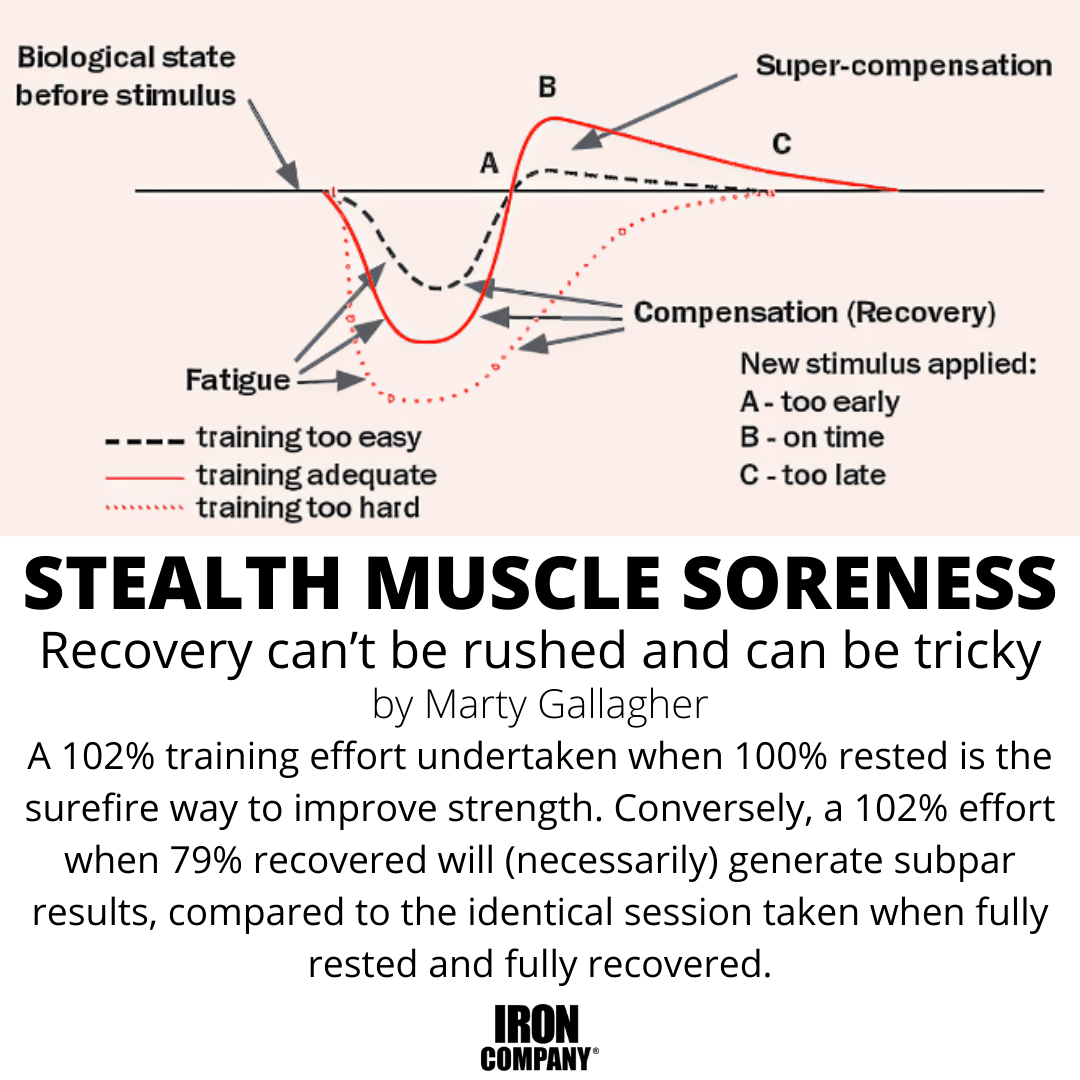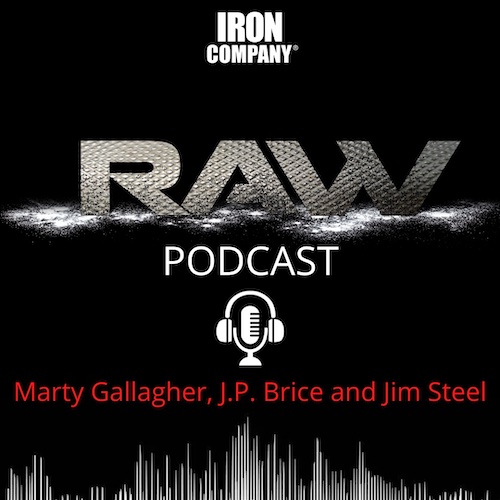
Stealth Muscle Soreness
Recovery can’t be rushed and can be tricky
Can anyone logically disagree with the premise that engaging in a strength training session before fully recovered from the previous strength training session will, necessarily, generate subpar results, compared to the identical session done in the identical way when fully rested?
A 102% training effort undertaken when 100% rested is the surefire way to improve strength. Conversely, a 102% effort when 79% recovered will (necessarily) generate subpar results, compared to the identical session taken when fully rested and fully recovered.
How long does it take to fully recover from an effective, hypertrophy-inducing resistance training session? How do you know when the recovery is complete? Are there telltale signs that betray an incomplete recovery or lingering recovery? Are there methods and modes, substances, or nutrients that can and will accelerate recovery? The length of time needed to recover from a result-producing resistance training session varies, depending on a multiplicity of factors…
- type and kind of resistance training
- fitness or unfitness of the trainee
- workout frequency
- types and degrees of intensities undertaken and experienced
- session duration
- “outside” factors
Outside factors could include, working overtime, sickness, excellent or horrible interpersonal relationships, life stress (negative) or lack of stress (positive)…outside factors are not necessarily always negative; outside factors can be a positive or neutral.
Recovering from a truly effective training session is subtle and requires careful attention. If a strength training session is successful, the trainee self-induces physical trauma. Unless there is trauma of a sufficient intensity, sufficient to shock the body, there is no need to worry about recovery. Without trauma and hypertrophy there is nothing to recover from. Recovery criteria include…
| Time | wait long enough and experience full and complete recovery |
| Nutrition | sufficient calories accelerates recovery, insufficient calories retard recovery |
| Massage | expert manual manipulation of traumatized muscles dislodges toxins and waste products |
| Hydro/Heat | steam, sauna, whirlpool, ice baths, etc., all have been shown to shorten recovery |
| Active Rest | lightly flushing recovering muscles, if not overdone or underdone, can aide the recovery effort |
| Sleep | deep REM sleep accelerates recovery. Conversely, a lack of sleep, restless sleep, retards recovery |
Recovery is the red-headed stepchild of modern resistance training. Coaches, personal trainers, resistance training experts, all differentiate themselves, one from one another, based on the complexities and newness of their training approach.
Very little attention is paid to the empty gaps, the time elapsed between sessions – the secret sauce is what they, the experts, do within the session. For most, more sessions mean more opportunity to showcase their content expertise – recovery be damned.
An athlete can only obtain optimal strength training results by commencing a strength training session 100% rested. Anything less than fully rested dilutes results: how is a trainee to ever become fully rested weight training five times a week? Where does the rest come from?
You shock-blast the legs on Sunday and expect this to have zero impact on the bench press workout on Tuesday “because benching uses arms, chest and shoulders while leg work uses quads, hams and calves…completely different muscles.” Indeed, attached to the same body. The same body desperately seeking homeostasis after being slaughtered on Sunday.
If allowed, the human body is a remarkable self-healing machine. After a body-shattering, result-producing, hardcore resistance training session, and given enough time (and assuming the body is fed and rested) supercompensation occurs: the trained, fed, and rested body skyrockets passed homeostasis and onward into the creation of new muscle tissue and a concurrent increase in raw power and strength.
Muscle building is a defensive tactic, a bodily reaction to the pounding the body experiences during a proper training session. The body tells itself, ‘look, these stresses are past our capacities: we need more muscular firepower to deal with this overload, this continual pounding.’ The bodily solution is to build bigger muscles, thereby creating additional strength, this to deal with these reoccurring and past-capacity physical stresses.
In my own experience, I recently discovered that I was inadvertently undercutting my recovery. There is a phenomenon in resistance training called Delayed Onset Muscle Soreness, DOMS. In my case, I had forgotten about DOMS.
I had been training hard every Sunday, waking up the next morning, feeling great with zero telltale soreness. Because of a lack of telltale soreness denoting fatigue, because I was fired-up psychologically, I would train hard again Monday morning, attacking different body parts.
I had recently shifted my training strategy, dramatically, from a low-volume, high-intensity, power-training approach into a high-volume, moderate-intensity broader, lighter, approach. I was seeking to invoke some neuroplasticity in my training by doing different things, I noted that some of my minor muscles (specific tricep heads, specific quadricep heads) were not firing, not contracting during my squats, bench presses, deadlifts, overhead presses, or their acceptable variants. Like sucker fish attached to sharks, these portions of muscles figured out that they didn’t have to fire during a squat or bench press. They would tag along for the ride.
The rear head of my left tricep refused to fire and had become deflated. It had “forgotten” how to contract. The solution? Lots of tricep isolation exercises where I forced the laggard tri-head to contract. Ditto the inner teardrop of my right quadricep: I forcibly contract it using slo-mo precision leg extensions. Overall, I shifted my focus: I began using more exercises, more sessions, I shifted the emphasis from poundage and technique to contraction, feel, isolation.
After heavy squats and deadlifts, switching to Smith Machine squats and leg extensions, tricep pushdowns and lat pulldowns, seemed like a walk in the park. I had fallen into a predictable pattern: I would have an excellent training session on Sunday when I trained with my training partners. Predictably, I would feel great Monday morning.
Psychologically fired up, I would tear into another session on Monday, attacking entirely different muscles. I would post a good (not excellent) session on Monday and attribute the falloff to training alone as opposed to the psychological boost I get working out with my training partners.
After a killer session on Sunday, a good session on Monday, I would hit a light arm workout on Wednesday. I would wake up Thursday sore and tired. It would take Thursday, Friday, and Saturday to get back into the “I feel fresh and ready” headspace needed for Sunday when I trained with the boys and the whole cycle commenced again.
I was new to the pee-wee poundage/high volume game and was feeling my way along. Suddenly I was doing lots of exercises, going to failure with light poundage and using a lot of isolation movements. I also began using resistance machines. A few weeks ago, after having had another excellent Sunday session, I was forced to skip the Monday training session on account of some deadlines and pressing life situations. Again, I awoke that Monday morning feeling fabulous. I felt 100% rested, ready, and looking forward to my Monday session. I was distraught at having to cancel training.
Around 1 pm in the afternoon I began to experience some serious soreness in my traps, erectors, rear delts, triceps, biceps, and hamstrings. Gee, on Sunday I had done eight sets of five reps in the overhead barbell press. Then 5 sets of 2-rep sets of power cleans, setting a (recent) personal best. Followed by four sets of slo-mo-to-failure lying leg curls. Five super-sets of 6-10 reps in the steep incline curls were alternated with single dumbbell overhead tricep extensions, lots of sets taken to failure.
By 4pm on Monday my soreness had increased exponentially: I was really sore in my shoulders, upper back, hamstrings and arms. Really sore. The revelation hit me: if I had felt this degree of soreness and fatigue when I woke up Monday morning, there was NO WAY I would have even considered working out.
Further, by layering another workout, a good one (Monday), atop a great workout (Sunday) and then throwing a “light workout” in on Wednesday, I was digging myself a massive recovery hole to climb out of. This was DOMS, delayed onset muscular soreness, gone stealth.
The solution? I could not correct what I was unaware of: I made it a point to abstain from resistance training Monday – no matter how good I felt Monday morning. That was a month ago. I would not consider weight train again until Wednesday or Thursday. I might or might not slip in a “light” session on Friday, or skip it. Two to three weekly lifting sessions are interspersed with four weekly cardio sessions (sprint, bike, swim.)
I try and walk right up to the cusp of too much, that is where the gains lie. There is an old cliché about love and loss, “Time heals all.” This catchphrase could also be the motto for resistance training recovery: time (away from resistance training) allows the human body the rest needed to repair, rebuild, strengthen, and grow. Training hard enough to trigger hypertrophy is only one third of the growth equation.
The muscle(s,) traumatized in the training session, need post-workout nutrients to replenish and revitalize. The shocked and fed muscles must then be “rested,” i.e., left alone till a full and complete recovery occurs. Further, decimated muscles in one sector of the body should serve as fair warning to not train differing muscles: the entire body needs to be recovered, not just certain sectors.
There is no such thing as a partial full recovery. Be aware of the DOMS phenomenon: there can be a 36 or 48-hour lag time before the full fury of the soreness reveals itself. The best advice I can give is err on the side of too much recovery time versus too little. On the other hand, don’t use recovery as an excuse to undertrain: train hard, replenish, rest, regain homeostasis, repeat ad infinitum.
About the Author - Marty Gallagher
As an athlete Marty Gallagher is a national and world champion in Olympic lifting and powerlifting. He was a world champion team coach in 1991 and coached Black's Gym to five national team titles. He's also coached some of the strongest men on the planet including Kirk Karwoski when he completed his world record 1,003 lb. squat. Today he teaches the US Secret Service and Tier 1 Spec Ops on how to maximize their strength in minimal time. As a writer since 1978 he’s written for Powerlifting USA, Milo, Flex Magazine, Muscle & Fitness, Prime Fitness, Washington Post, Dragon Door and now IRON COMPANY. He’s also the author of multiple books including Purposeful Primitive, Strong Medicine, Ed Coan’s book “Coan, The Man, the Myth, the Method" and numerous others. Read the Marty Gallagher Biography for a more in depth look at his credentials as an athlete, coach and writer.



